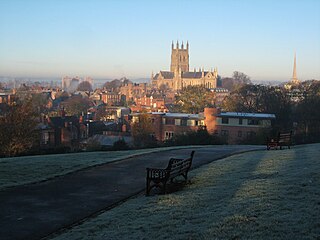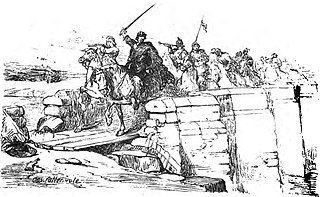
The Battle of Worcester took place on 3 September 1651 in and around the city of Worcester, England and was the last major battle of the 1642 to 1651 Wars of the Three Kingdoms. A Parliamentarian army of around 28,000 under Oliver Cromwell defeated a largely Scottish Royalist force of 16,000 led by Charles II of England.

The Second English Civil War took place between February and August 1648 in England and Wales. It forms part of the series of conflicts known collectively as the 1639–1653 Wars of the Three Kingdoms, which include the 1641–1653 Irish Confederate Wars, the 1639–1640 Bishops' Wars, and the 1649–1653 Cromwellian conquest of Ireland.

The Anglo-Scottish war (1650–1652), also known as the Third Civil War, was the final conflict in the Wars of the Three Kingdoms, a series of armed conflicts and political machinations between shifting alliances of religious and political factions in England, Scotland and Ireland.
The First Battle of Middlewich took place on 13 March 1643, during the First English Civil War, and was fought between the Parliamentarians, under Sir William Brereton, and the Royalist supporters of King Charles I of England, under Sir Thomas Aston.

Fort Royal Hill is a park in Worcester, England, and the site of the remains of an English Civil War fort.

The second and longest siege of Worcester took place towards the end of the First English Civil War, when Parliamentary forces under the command of Thomas Rainsborough besieged the city of Worcester, accepting the capitulation of the Royalist defenders on 22 July. The next day the Royalists formally surrendered possession of the city and the Parliamentarians entered Worcester 63 days after the siege began.

The Battle of Stow-on-the-Wold took place during the First English Civil War. It was a Parliamentarian victory by detachments of the New Model Army over the last Royalist field army.
1646 was the fifth and final year of the First English Civil War. By the beginning of 1646 military victory for the Parliamentary forces was in sight. A Royalist army was defeated in the field at the Battle of Torrington on 16 February and the last Royalist field army was defeated at the Battle of Stow-on-the-Wold on 21 March. From then on the New Model Army cleared the remaining Royalist strongholds. The politics moved into a post-war phase with all the major factions in England and Scotland trying to reach an accommodation with King Charles I that would further their own particular interests.

Worcestershire was the county where the first battle and last battle of the English Civil War took place. The first battle, the Battle of Powick Bridge, fought on 23 September 1642, was a cavalry skirmish and a victory for the Royalists (Cavaliers). The final battle, the battle of Worcester, fought on 3 September 1651, was decisive and ended the war with a Parliamentary (Roundhead) victory and King Charles II a wanted fugitive.

Booth's Uprising, also known as Booth's Rebellion or the Cheshire Rising of 1659, was an unsuccessful attempt in August 1659 to restore Charles II of England. Centred on North West England and led by George Booth, it took place during the political turmoil that followed the resignation of Richard Cromwell as head of The Protectorate.

Robert Venables was an English soldier from Cheshire, who fought for Parliament in the 1638 to 1651 Wars of the Three Kingdoms, and later served under the Commonwealth of England.

The Battle of Preston, fought largely at Walton-le-Dale near Preston in Lancashire, resulted in a victory for the New Model Army under the command of Oliver Cromwell over the Royalists and Scots Engagers commanded by the Duke of Hamilton. The Parliamentarian victory presaged the end of the Second English Civil War.
The Battle of Kings Norton was fought on 17 October 1642. The skirmish developed out of a chance encounter between Royalists under the command of Prince Rupert and Parliamentarians under the command of Lord Willoughby. Both forces had been on their way to join their respective armies which were later to meet at Edgehill in the first pitched battle of the First English Civil War. The Parliamentarians won the encounter and both forces proceeded to join their respective armies.

Thomas Birch, c. 5 June 1608 to 5 August 1678, was an English landowner, soldier and radical Puritan who fought for Parliament in the Wars of the Three Kingdoms, and sat in the House of Commons at various times between 1649 and 1658.

The Battle of Upton was fought on 28 August 1651 when a New Model Army detachment under the command of Colonel John Lambert made a surprise attack on Royalists defending the river Severn crossing at Upton-upon-Severn, 6 miles (9.7 km) below Worcester. In the action which followed, the Royalist commander Major General Edward Massey was severely wounded and the surviving Royalists were driven out of the town and north along the Worcester Road.
Colonel Sir Gilbert Gerard was a Royalist officer during the English Civil War. He served as Governor of Worcester, fighting a campaign against the Parliamentarian Tinker Fox, and died there in 1646 with the conflict still ongoing.

The Battle of Ripple Field, fought on 13 April 1643, was an engagement in the First English Civil War. In the battle, a Royalist cavalry force led by Prince Maurice routed Parliamentarian cavalry and infantry forces led by Sir William Waller.
The Battle of Stourbridge Heath was a skirmish that took place during the First English Civil War, in which a Parliamentarian contingent under the command of Colonel "Tinker" Fox was defeated by a larger Royalist force under the command of Sir Gilbert Gerard, Governor of Worcester.

The Battle of Winnington Bridge, often described as the last battle of the English Civil War, took place on 19 August 1659 during Booth's Uprising, a Royalist rebellion in north-west England and Wales.

The Battle of Winwick was fought on 19 August 1648 near the Lancashire village of Winwick between part of a Royalist army under Lieutenant General William Baillie and a Parliamentarian army commanded by Lieutenant General Oliver Cromwell. The Royalists were defeated with all of those who took part in the fighting, their army's entire infantry force, either killed or captured. The Royalist mounted component fled but surrendered five days after the battle. Winwick was the last battle of the Second English Civil War.














